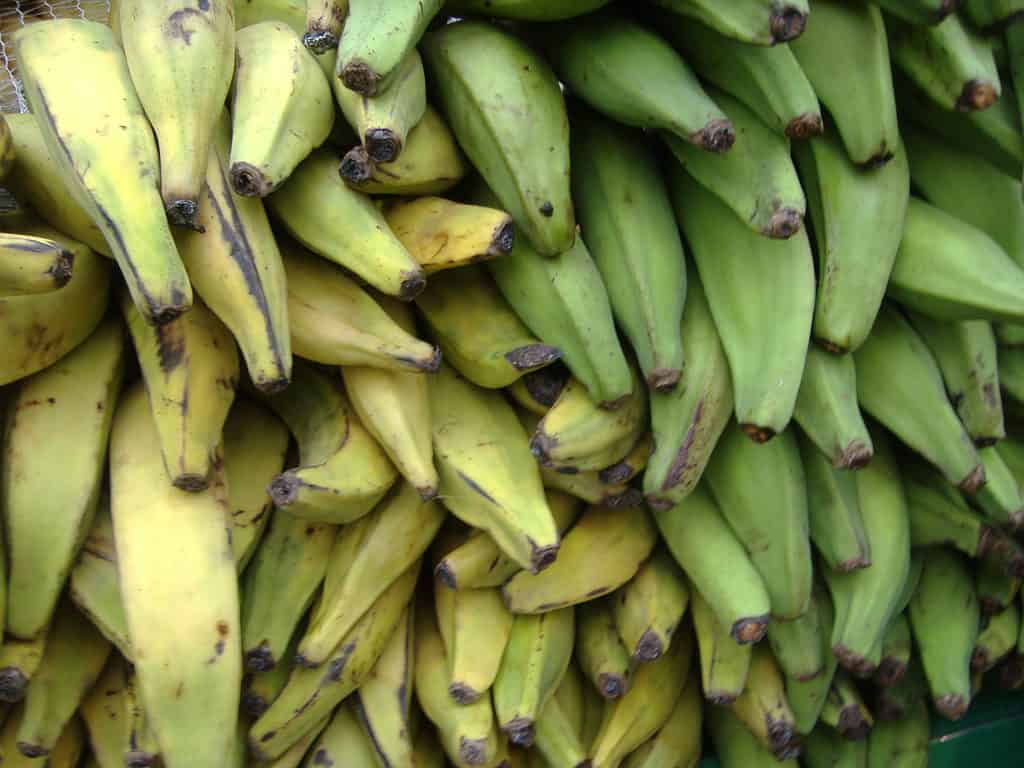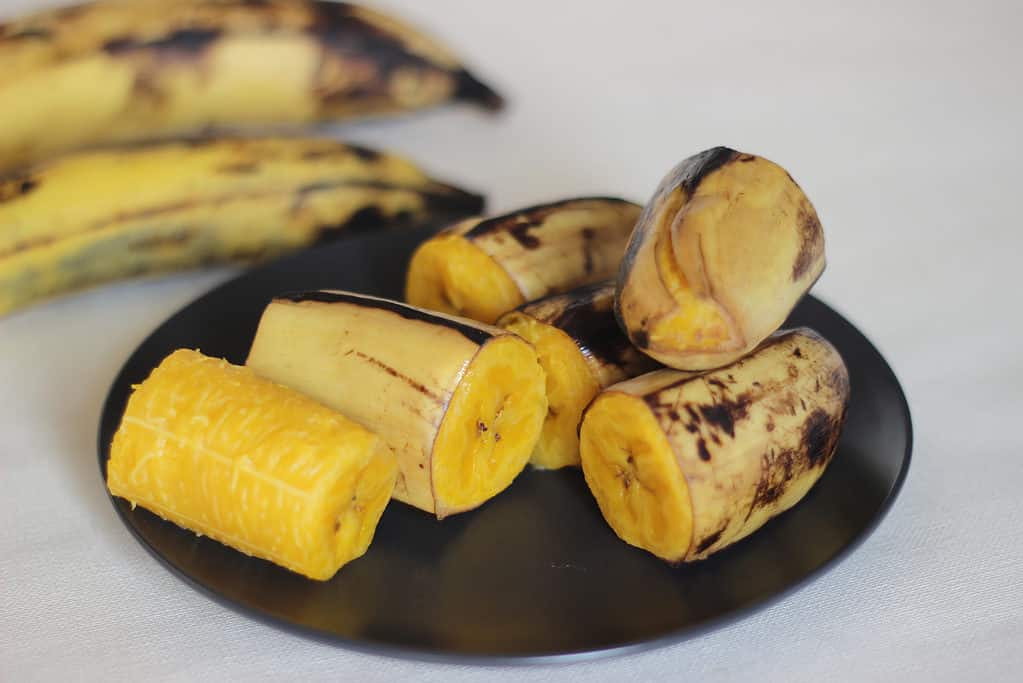Dogs can eat a small amount of plantains safely if they are cooked. However, the raw fruit can be a choking hazard, especially if your dog tends to scarf stuff down. We recommend boiling or otherwise cooking the plantains to soften them before giving them to your dog. Cutting them into small pieces can also be helpful. The size depends on the size of your dog.
Of course, you should not only feed your dog plantains. They are high in carbohydrates and do not contain all the nutrients your dog needs. In a small amount, they can be a healthy snack. However, your dog should mostly be consuming their complete, commercial dog food (or a well-formulated home diet).

Dogs can eat a small amount of plantains safely if they are cooked.
©Luigi Guarino / Flickr – License
Potential Benefits of Plantains
A small amount of plantains may be beneficial to some dogs. However, as we’ve stated, you should not feed your dog high amounts. Here are some reasons you may want to add plantains to your dog’s diet.
1. Fiber
Plantains are high in fiber. Fiber is an essential part of a dog’s diet, though it is often overlooked. Fiber helps the microbiome in a dog’s stomach thrive, preventing digestive issues and supporting the immune system. Therefore, fiber is essential, and many dogs could likely use more of it than provided in the typical diet.
Of course, we recommend asking your vet before adding considerable amounts of fiber to your pet’s diet. Fiber is excellent for obese dogs but may not be suitable for underweight dogs.
2. Blood Sugar Stability
Anytime your dog eats, their blood sugar rises. When they run out of new sugars, their blood sugar lowers. It works the same in dogs as it does in humans. Too high and too low blood sugar can cause issues. Luckily, fiber helps slow the digestion of sugar, which lessens the blood sugar spike.
Therefore, dogs with difficulty controlling their blood sugar may benefit from plantains. Many smaller dogs fit into this category, as do dogs with diabetes. However, because plantains are high in carbs, they are not the best option for dogs with diabetes unless directed by your vet.
3. Immune-Boosting Nutrients
Plantains contain an assortment of immune-boosting nutrients. For instance, antioxidants, vitamin C, and vitamin A are all included in high amounts. Therefore, plantains can easily be considered an immune-boosting snack.
However, it’s essential to realize that these nutrients won’t continually boost your pet’s immune system. There is a maximum where these vitamins no longer do any good. In very high amounts, they can even harm your dog. These high amounts aren’t typically accessible through regular diet, though. Instead, overdosing usually only occurs when supplements are used.
3. Lowering Inflammation
Plantain fruit may help lower inflammation in certain circumstances. The plant has anti-inflammatory properties, according to some. However, the scientific literature isn’t very clear on this benefit. Therefore, while plantains can have this benefit, we would probably recommend something more researched if your dog needs to lower their inflammation.
Potential Downsides of Plantains
Of course, plantains aren’t all good. Some potential downsides to feeding this plant should be considered before offering anything to your dog.
1. Choking
Uncooked plantain can be very tough, as it contains a lot of fiber. Therefore, it’s essential to cook the plantain before giving it to your dog. In many cases, you should also break the plant up into small pieces. Smaller dogs will need their food cut into very small pieces, while large dogs may not need it cut.
Choking can be very serious and potentially deadly, so prepare the plantain correctly.
2. Gastrointestinal Problems
As you might imagine, many dogs aren’t used to eating plantains. Therefore, dogs can quickly develop gastrointestinal problems after eating plantains. For this reason, we only recommend giving your dog a small amount. Smaller amounts are less likely to cause stomach upset.
If you need to give your dog larger amounts of plantains, slowly work up to it.
Furthermore, don’t give your dog fried plantains. The excess fat increases the odds of stomach upset.
Luckily, any stomach issues linked to the plantains should clear up within 24-48 hours. There usually isn’t any reason to talk to your vet unless your dog has an underlying issue that may make the stomach upset serious.
3. Obesity
Plantains are incredibly high in sugars and carbohydrates. Therefore, excessive consumption can lead to obesity. Obesity isn’t fun and can lead to all sorts of health problems. Sadly, obesity is a serious problem in many developed countries. Almost half of all dogs are overweight – that number isn’t decreasing.
Therefore, it is vital that you carefully watch your dog for signs of weight gain and take the correct steps necessary to fix the issue before it goes out of control.

Only a small amount of plantain should be fed to dogs at any one time to avoid stomach upset.
©iStock.com/igorr1
Are Plantains Toxic to Dogs?
Plantains aren’t blatantly toxic to dogs. In fact, when eaten in small amounts, they can be nutritional snacks. However, it is essential to prepare these fruits carefully without any seasoning. Many types of seasonings are toxic to dogs, so it is vital to avoid using seasonings when cooking plantains for your dog.
Furthermore, you shouldn’t fry the plantain. Fried plantain isn’t necessarily toxic. However, excessive fat can cause stomach issues. Therefore, all dogs should avoid fried foods, even if fried food is “healthy.”
While practically any method but frying will work, steaming is considered the best option. It helps maintain as many nutrients in the plantain as possible while still softening it up substantially. Generally, plantain can be cooked the same way as potatoes.
Plantain Fruit vs. Herb
There are two different kinds of plantain: fruit and herb. Neither is toxic to dogs, so you don’t necessarily have to worry about telling the two apart. However, this isn’t challenging since one is a fruit, and another is a leaf.
Both have fairly similar benefits. However, the herb is commonly used for topical purposes, such as on wounds. The fruit isn’t used for this purpose. Many people find the fruit tastier and easier to cook. Plus, the fruit is often easier to find in grocery stores. (However, the herb is native to many areas of the world.)
Ways to Feed Your Dog Plantain
If you decide to feed your dog plantain, there are several ways to go about it. Whether you feed them the fruit plantain or the herb plantain, both parts can be prepared in various ways. Here are some of our favorite methods:
- Fresh leaves: You can provide your dog with the fresh leaves of the plantain herb. The leaves must be bruised or crushed to release their benefits, but this will happen whenever you give your dog the plant to eat. Still, we only recommend this in tiny amounts, as too many leaves can quickly upset a dog’s stomach.
- Plantain juice: You can also juice the plant to provide your dog with all the benefits without the potential for choking. However, juicing can remove some of the fiber, so you may use another method if you’re mostly after the fiber content. We recommend adding small amounts of juice to your dog’s regular food.
- Steamed: If you’re feeding the fruit, we recommend feeding it steamed. This makes it very soft, but it also doesn’t require any added ingredients. Steam the plantain until it is soft enough to mash, and give it to your dog. Don’t add any seasonings, as some of these are toxic.

The best way to serve plantain to your dog is to steam it until soft and cut it up into smaller pieces to ensure they do not choke.
©iStock.com/Jogy Abraham
Final Thoughts
Plantain isn’t toxic to dogs. In fact, it may have several different benefits, including a high fiber content. Dogs that need more fiber in their diet may benefit from the occasional consumption of plantain. However, this fruit doesn’t contain everything your dog needs in their diet. Therefore, it should only be an occasional snack.
You’ll see a lot of claims regarding this fruit’s benefits. However, many of them are not backed by science.
There are some potential downsides, as well. This fruit can upset your dog’s stomach, especially if they are not used to eating it. Therefore, we recommend starting at very low amounts and slowly working your way up.
Up Next
- Can Dogs Eat Maple Syrup?
- Can Dogs Eat Romaine Lettuce?
- Why Can’t Dogs Eat Almonds? What Are The Unsafe Toxins?
The photo featured at the top of this post is © iStock.com/itsten
Ready to discover the top 10 cutest dog breeds in the entire world?
How about the fastest dogs, the largest dogs and those that are -- quite frankly -- just the kindest dogs on the planet? Each day, AZ Animals sends out lists just like this to our thousands of email subscribers. And the best part? It's FREE. Join today by entering your email below.
Thank you for reading! Have some feedback for us? Contact the AZ Animals editorial team.






